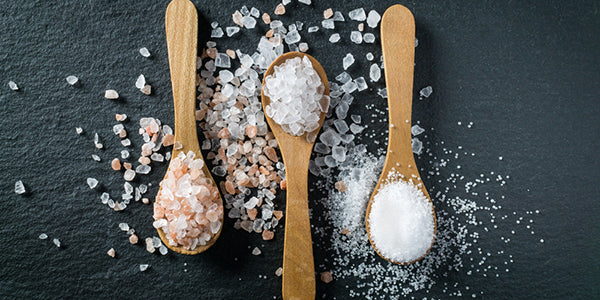
As the major focus has been on sugar intake, the public may be misinformed when it comes to moderating sodium intake.
With weight loss advice being so focused on limiting bad sugar from the diet, it is time to shine the light of too much salt in the diet. We answer, "How much sodium is too much?" and other questions about the mineral.
The Role of Sodium in the Body
First and foremost, though, the role of sodium in the body is vital to health when consumed in moderate amounts. The mineral and electrolyte is involved in countless processes, including:
• Balances and normalizes body fluids
• Helps send nerve impulses
• Impacts muscle function
The negativity of sodium mostly stems from its large intake in the Americanized diet, particularly in the forms of processed, convenience foods with added salt.
Overall, the Americanized diet consumes too much sodium in the forms of convenience, processed foods. In fact, the average American consumes approximately 3,400 milligrams (mg) of sodium per day.
The Dietary Guidelines for Americans (DGAs) and American Heart Association (AHA) recommend 2,300 mg per day. What's more, the AHA encourages adults to work towards 1,500 milligrams of sodium daily.
Effects of Too Much Sodium on Weight
Too much salt is well-known for majorly increasing the risk of high blood pressure (hypertension) and heart disease. Constant increases in blood pressure can damage the arteries and lead to plaque on the walls. Eventually, this increases the risk of heart failure, stroke, and heart attack.
But researchers from the University of Helsinki suggest salt intake is strongly linked to obesity. Other research shows a 1 gram per day increase in salt intake increases the risk of obesity by 28 percent in children and 26 percent in adults.
A few theories imply excess sodium can make weight loss a challenge, including common high-salt foods. A link between sodium and diabetes may speak to this phenomenon as well.
1. The High-Salt Food Sources
While sodium is virtually absent of calories, it is abundant in processed convenience foods such as chips, pizza, bread, among numerous others. It can even be loaded in foods that seem "healthy," including salad dressings and frozen veggies.
These sorts of foods tend to be laden in calories without supplying much nutritional value, along with being easier to overeat.
2. Excess Sodium is Linked to Diabetes
A high-sodium diet increases the risk of high blood pressure, in turn increasing the risk of diabetes. Diabetes is a major health concern and makes weight loss a challenge, especially in the presence of insulin resistance.
People who are insulin resistant do not effectively use insulin, which is the hormone responsible for shuttling glucose into cells. The cells become quite desperate for fuel, which in turn causes them to send "I'm hungry!" signal to the brain and subsequently increases the risk of overeating.
Those with higher insulin levels also store fat more effectively. This increases the risk of weight gain and additional health concerns.
3. Salty Diets Can Increase Hunger
While salt was previously thought to stimulate thirst, researchers have now discovered it can increase hunger. And unfortunately, this can further increase the risk of overeating.
How to Maintain a Low-Salt Diet
Again, sodium is devoid of calories. However, it is abundant in calorically-dense foods that are often over-consumed.
No sodium recommendation amounts currently exist to support weight loss. But, remember, the AHA recommends no more than 2,300 mg per day unless directed by a doctor.
Keeping sodium moderated helps reduce the risk of fluid retention and water weight in the short-term. Moderating sodium likewise lowers the long-term risks of obesity and other health conditions. These include stroke, heart failure, osteoporosis, kidney disease, and certain types of cancers.
Tips for achieving a low-salt diet include knowing and reducing high-sodium foods and checking food labels. Including more fresh foods and seasonings when cooking are helpful, too.
1. Know and Reduce High-Sodium Foods
Knowing where sodium resides and hides can help individuals make more mindful decisions. Sodium is commonly added and sourced in condiments such as ketchup and tomato, pasta, BBQ, and soy sauces.
Also watch out for foods that are fermented, cured, smoked, or pickled. These foods often include sauerkraut, pickles, cheeses, and lunch meats.
2. Check Food Labels
Food labels help consumers identify sodium content, particularly on packaged and boxed foods. These sodium claims are often found on food labels and can help guide food choices:
• Sodium-free: Less than 5 mg per serving
• Salt-free: Meets requirements for sodium-free
• Low-sodium: 140 mg sodium or less per serving
• Very low-sodium: 35 mg or less per serving
Additionally, check the mg of sodium per serving on the Nutrition Facts label to evaluate the product. Additional sodium descriptions include the following:
• Reduced sodium: Contains at least 25 percent less sodium compared to the regular version of the product.
• Light in sodium: Contains 50 percent less sodium per serving compared to the sodium in a regular version of the product.
• Unsalted, without added salt, and no salt added: No salt is used in the processing of the product. The product would normally be processed with salt (such as unsalted pretzels versus regular pretzels). This does not entitle the product to be "sodium-free."
3. Purchase Fresh Foods
Reduce packaged and processed products and purchase more fresh foods. Following diet recommendations from the DASH (Dietary Approach to Stop Hypertension) diet can naturally reduce the consumption of salt.
Recommended foods include:
• Whole grains
• Fruits and veggies
• Low- or non-fat dairy products
• Fish and poultry
• Legumes
• Nuts and seeds
As a general rule of thumb, consume 3 servings of veggies and 2 servings of fruits daily. These can come in fresh or frozen varieties, just be mindful of often added ingredients in frozen products.
Including more potassium-rich produce, such as bananas and carrots, can naturally reduce high blood pressure as well.
4. Use Fresh Herbs and Seasonings
Just one teaspoon of table salt contains 2,300 mg of salt! Sauces and condiments are also typically loaded with sodium, fat, and sugar.
Limit using the salt shaker when cooking and at the table. Instead, amplify flavor with fresh herbs, spices, and other seasonings as a salt substitute.
References:
How much sodium should I eat per day? American Heart Association. https://www.heart.org/en/healthy-living/healthy-eating/eat-smart/sodium/how-much-sodium-should-i-eat-per-day.
Ma Y, He FJ, Macgregor GA. High Salt Intake. Hypertension. 2015;66(4):843-849. doi:10.1161/hypertensionaha.115.05948.





